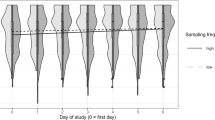Summary
Ambulatory assessment studies may provide important insights in the etiology of suicidal behaviors, because suicidal behaviors and their risk factors fluctuate over time.
The review aims at (1) evaluating the current state of research and (2) summarizing main findings in this field. Reviewed studies (N = 4) were heterogeneous. Up to 74 % of participants reported suicidal ideation during ambulatory assessment sampling. Suicidal ideation was predicted by intensity and instability of negative affective states (e.g., worry, sadness). Ambulatory assessment studies seem a promising approach to uncover the dynamic course of suicidal ideation and its risk factors in clinically relevant time frames (i.e., real-time).
Zusammenfassung
Studien mit ambulanten Assessments können wichtige Einblicke in die Ätiologie suizidaler Verhaltensweisen ermöglichen, da Suizidalität und assoziierte Risikofaktoren zeitlich fluktuierend auftreten.
Der Übersichtsartikel soll 1) die aktuelle Studienlage bewerten und 2) relevante Befunde aus vorhandenen Studien zusammenfassen. Die eingeschlossenen Studien (N = 4) waren heterogen. Bis zu 74 % der Studienteilnehmer berichteten Suizidgedanken während des ambulanten Assessments. Suizidgedanken wurden durch die Intensität und Instabilität negativer affektiver Zustände (z. B. Sorge, Traurigkeit) vorhergesagt. Studien, die diese vielversprechende Methode anwenden, könnten den dynamischen Verlauf von Suizidgedanken und seiner Risikofaktoren in klinisch relevanten Zeitfenstern (d. h. in Echtzeit) abbilden.
Similar content being viewed by others
References
World Health Organization. Suicide. 2014. http://www.who.int/mental_health/prevention/suicide/suicideprevent/en. Accessed 1 July 2014.
Chesin M, Stanley B. Risk assessment and psychosocial interventions for suicidal patients. Bipol Dis. 2013;15(5):584–93.
Fassberg MM, Van Orden KA, Duberstein P, Erlangsen A, Lapierre S, Bodner E, et al. A systematic review of social factors and suicidal behavior in older adulthood. Int J Environ Res Public Health. 2012;9(3):722–45.
Nock MK, Borges G, Bromet EJ, Cha CB, Kessler RC, Lee S. Suicide and suicidal behavior. Epidemiol Rev. 2008;30(1):133–54.
Hawton K, Comabella C, Haw C, Saunders K. Risk factors for suicide in individuals with depression: a systematic review. J Affect Dis. 2013;147(1–3):17–28.
Rudd MD, Berman AL, Joiner TE, Nock MK, Silverman MM, Mandrusiak M, et al. Warning signs for suicide: theory, research, and clinical applications. Suicide Life Threat Behav. 2006;36(3):255–62.
Hendin H, Al Jurdi RK, Houck PR, Hughes S, Turner J. Role of intense affects in predicting short-term risk for suicidal behavior a prospective study. J Nerv Ment Dis. 2010;198(3):220–5.
Hendin H, Maltsberger JT, Szanto K. The role of intense affective states in signaling a suicide crisis. J Nerv Ment Dis. 2007;195(5):363–8.
Witte TK, Fitzpatrick KK, Joiner TE, Schmidt NB. Variability in suicidal ideation: a better predictor of suicide attempts than intensity or duration of ideation? J Affect Dis. 2005;88(2):131–6.
Trull TJ, Ebner-Priemer UW. Using experience sampling methods/ecological momentary assessment (ESM/EMA) in clinical assessment and clinical research: introduction to the special section. Psychol Assess. 2009;21(4):457–62.
Myin-Germeys I, Oorschot M, Collip D, Lataster J, Delespaul P, van Os J. Experience sampling research in psychopathology: opening the black box of daily life. Psychol Med. 2009;39(9):1533–47.
Trull TJ, Ebner-Priemer U. Ambulatory assessment. Annu Rev Clin Psychol. 2013;9:151–76.
Links PS, Eynan R, Heisel MJ, Barr A, Korzekwa M, McMain S, et al. Affective instability and suicidal ideation amd behavior in patients with borderline personality disorder. J Personal Dis. 2007;21(1):72–86.
Ben-Zeev D, Young MA, Depp CA. Real-time predictors of suicidal ideation: mobile assessment of hospitalized depressed patients. Psychiatr Res. 2012;197(1–2):55–9.
Nock MK, Prinstein MJ, Sterba SK. Revealing the form and function of self-injurious thoughts and behaviors: a real-time ecological assessment study among adolescents and young adults. J Abnorm Psychol. 2009;118(4):816–27.
Husky M, Olie E, Guillaume S, Genty C, Swendsen J, Courtet P. Feasibility and validity of ecological momentary assessment in the investigation of suicide risk. Psychiatr Res. 2014;220:564–70.
Joiner T. Why people die by suicide. Cambridge: Harvard University Press; 2005.
Leboyer M, Slama F, Siever L, Bellivier F. Suicidal disorders: a nosological entity per se? Am J Med Gens Part C Sem Med Gen. 2005;133C(1):3–7.
Gould MS, Marrocco FA, Kleinman M, Thomas JG, Mostkoff K, Cote J, et al. Evaluating iatrogenic risk of youth suicide screening programs—a randomized controlled trial. J Am Med Assoc. 2005;293(13):1635–43.
Ebner-Priemer UW, Eid M, Kleindienst N, Stabenow S, Trull TJ. Analytic strategies for understanding affective (In)stability and other dynamic processes in psychopathology. J Abnorm Psychol. 2009;118(1):195–202.
Palmier-Claus J, Myin-Germeys I, Barkus E, Bentley L, Udachina A, Delespaul P, et al. Experience sampling research in individuals with mental illness: reflections and guidance. Acta Psychiatr Scand. 2011;123(1):12–20.
Ladwig KH, Klupsch D, Ruf E, Meisinger C, Baumert J, Erazo N, et al. Sex- and age-related increase in prevalence rates of death wishes and suicidal ideation in the community: results from the KORA-F3 Augsburg study with 3154 men and women, 35 to 84 years of age. Psychiatr Res. 2008;161(2):248–52.
Forkmann T, Braehler E, Gauggel S, Glaesmer H. Prevalence of suicidal ideation and related risk factors in the german general population. J Nerv Ment Dis. 2012;200(5):401–5.
Sokero TP, Melartin TK, Rytsala HJ, Leskela US, Lestela-Mielonen PS, Isometsa ET. Suicidal ideation and attempts among psychiatric patients with major depressive disorder. J Clin Psychiatr. 2003;64(9):1094–100.
Wichers M, Simons C, Kramer I, Hartmann J, Lothmann C, Myin-Germeys I, et al. Momentary assessment technology as a tool to help patients with depression help themselves. Acta Psychiatr Scand. 2011;124(4):262–72.
Author information
Authors and Affiliations
Corresponding author
Rights and permissions
About this article
Cite this article
Spangenberg, L., Forkmann, T. & Glaesmer, H. Investigating dynamics and predictors of suicidal behaviors using ambulatory assessment. Neuropsychiatr 29, 139–143 (2015). https://doi.org/10.1007/s40211-015-0142-1
Received:
Accepted:
Published:
Issue Date:
DOI: https://doi.org/10.1007/s40211-015-0142-1




